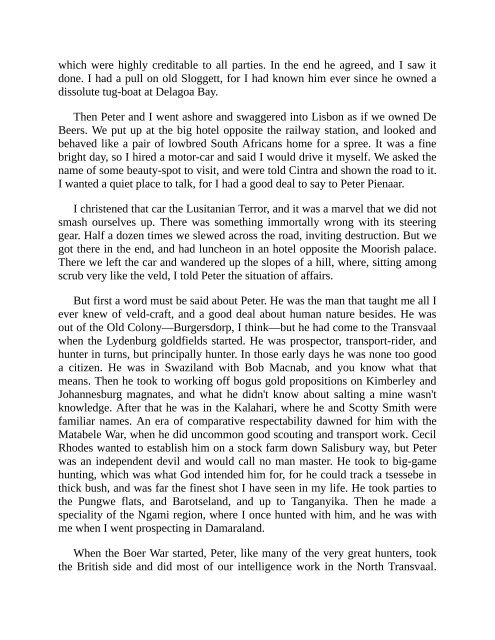Greenmantle - John Buchan
Greenmantle es la segunda de las cinco novelas de John Buchan con el personaje de Richard Hannay , publicado por primera vez en 1916 por Hodder & Stoughton , Londres . Es una de las dos novelas de Hannay ambientadas durante la Primera Guerra Mundial , la otra es el Sr. Standfast (1919); La primera y más conocida aventura de Hannay, The Thirty-Nine Steps (1915), se desarrolla en el período inmediatamente anterior a la guerra.
Greenmantle es la segunda de las cinco novelas de John Buchan con el personaje de Richard Hannay , publicado por primera vez en 1916 por Hodder & Stoughton , Londres . Es una de las dos novelas de Hannay ambientadas durante la Primera Guerra Mundial , la otra es el Sr. Standfast (1919); La primera y más conocida aventura de Hannay, The Thirty-Nine Steps (1915), se desarrolla en el período inmediatamente anterior a la guerra.
Create successful ePaper yourself
Turn your PDF publications into a flip-book with our unique Google optimized e-Paper software.
which were highly creditable to all parties. In the end he agreed, and I saw it<br />
done. I had a pull on old Sloggett, for I had known him ever since he owned a<br />
dissolute tug-boat at Delagoa Bay.<br />
Then Peter and I went ashore and swaggered into Lisbon as if we owned De<br />
Beers. We put up at the big hotel opposite the railway station, and looked and<br />
behaved like a pair of lowbred South Africans home for a spree. It was a fine<br />
bright day, so I hired a motor-car and said I would drive it myself. We asked the<br />
name of some beauty-spot to visit, and were told Cintra and shown the road to it.<br />
I wanted a quiet place to talk, for I had a good deal to say to Peter Pienaar.<br />
I christened that car the Lusitanian Terror, and it was a marvel that we did not<br />
smash ourselves up. There was something immortally wrong with its steering<br />
gear. Half a dozen times we slewed across the road, inviting destruction. But we<br />
got there in the end, and had luncheon in an hotel opposite the Moorish palace.<br />
There we left the car and wandered up the slopes of a hill, where, sitting among<br />
scrub very like the veld, I told Peter the situation of affairs.<br />
But first a word must be said about Peter. He was the man that taught me all I<br />
ever knew of veld-craft, and a good deal about human nature besides. He was<br />
out of the Old Colony—Burgersdorp, I think—but he had come to the Transvaal<br />
when the Lydenburg goldfields started. He was prospector, transport-rider, and<br />
hunter in turns, but principally hunter. In those early days he was none too good<br />
a citizen. He was in Swaziland with Bob Macnab, and you know what that<br />
means. Then he took to working off bogus gold propositions on Kimberley and<br />
Johannesburg magnates, and what he didn't know about salting a mine wasn't<br />
knowledge. After that he was in the Kalahari, where he and Scotty Smith were<br />
familiar names. An era of comparative respectability dawned for him with the<br />
Matabele War, when he did uncommon good scouting and transport work. Cecil<br />
Rhodes wanted to establish him on a stock farm down Salisbury way, but Peter<br />
was an independent devil and would call no man master. He took to big-game<br />
hunting, which was what God intended him for, for he could track a tsessebe in<br />
thick bush, and was far the finest shot I have seen in my life. He took parties to<br />
the Pungwe flats, and Barotseland, and up to Tanganyika. Then he made a<br />
speciality of the Ngami region, where I once hunted with him, and he was with<br />
me when I went prospecting in Damaraland.<br />
When the Boer War started, Peter, like many of the very great hunters, took<br />
the British side and did most of our intelligence work in the North Transvaal.














